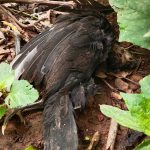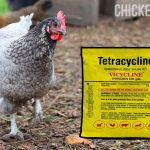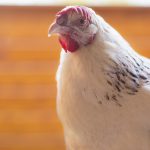Chicken Feathers Guide
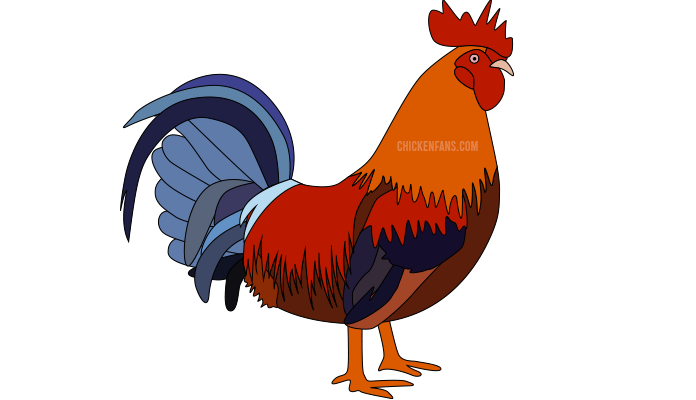
Chicken plumage consists of several feather groups that cover the bird’s body. These feather groups all have very specific names, which can be overwhelming if you are new to chickens.
We discuss the feathers of the hackles, saddle, tail, wings, and legs. Especially the wings have a complex feather structure. We also discuss more exotic topics like soft-feathered plumage, Eclipse Molt, and Henny Feathering.
- Chicken Plumage Overview
- Hackles
- Wing Feathers
- Facial Feathers
- Saddle Feathers
- Tail Feathers
- Leg and Feet Feathers
- Fluff
- Hard-Feathered vs. Soft-Feathered
- Chicken Molt
- Hen Feathering in Roosters
Chicken Plumage Overview
Chicken feathers come in several patterns, colors, and arrangements. The structure may seem random, but it is actually very well organized.
The feathers grow in feather tracts on the skin and form groups and overlapping rows.
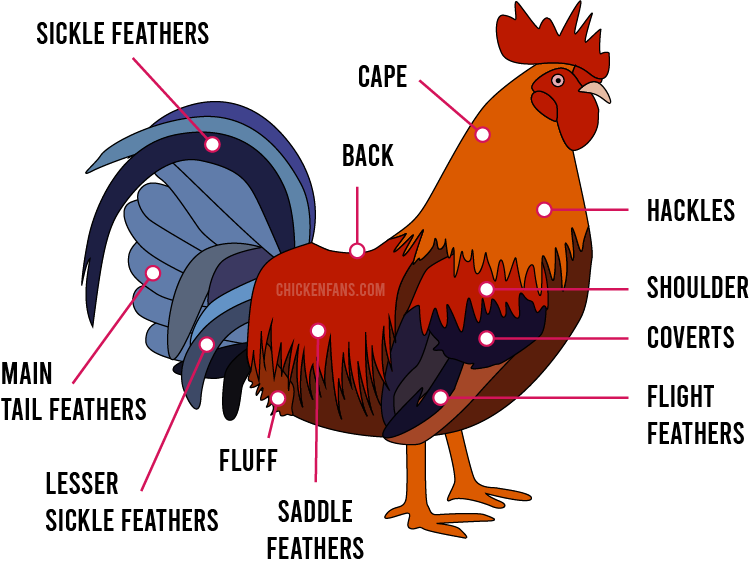
The main feather groups in a chicken plumage are:
- Hackles: neck feathers along the side and back of the neck (cape)
- Wing Feathers: flight and covert feathers on the wing
- Saddle Feathers: back feathers, long pointed feathers on the back of roosters
- Tail Feathers: main tail feathers and coverts, roosters also have long curved sickles
Chickens change their plumage during the molt.
Chicken Hackles
The hackles of a chicken are the long feathers on the side and back of the neck. Roosters raise their majestic hackles when ready to fight or to show dominance. Long, thin rooster hackles are popular in fly fishing as artificial flies in fly tying.
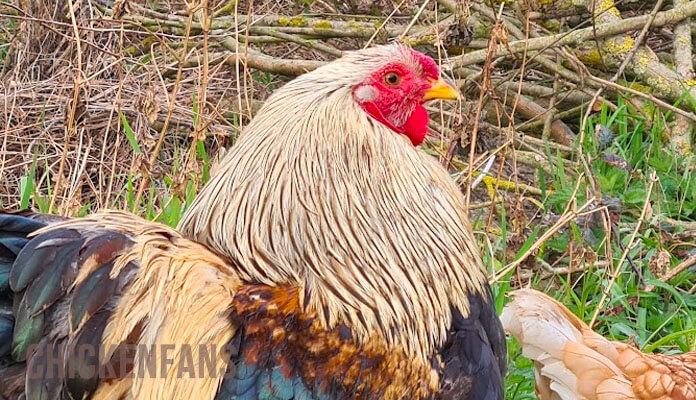
Most people are familiar with cats and dogs raising their hair when threatened or ready to attack. It’s part of the fight-or-flight response, a nervous system reflex in life-threatening situations. The same happens to roosters. The only difference is that they carry feathers. Be careful when a rooster has his hackles up.
Chicken’s hackles are very popular in fly fishing. The hackles make great dry flies that float on water. The feather’s barbs look like tendrils, making fish pluck the insects from the water’s surface.
Chicken Wing Feathers
There are many feather groups on a wing, which can be overwhelming. It’s easier to understand the terminology once you know the differences between flight feathers and covert feathers and how the feathers attach to the wing bones.
Flight Feathers vs. Covert Feathers
Flight feathers are long stiff feathers on the wing that the chicken uses to fly and lift off. Covert feathers cover the base of the flight feathers. They smoothen out the surface, so the bird is more aerodynamic.
Feathers usually grow on the skin, but the shaft of a flight feather anchors to the bone.
Primary Feathers vs. Secondary Feathers
The wing bones are very similar to our arms. Chickens fly with their forearms and hands. The flight feathers are attached to the ulna and metacarpals.
The feathers that attach to their hand and fingers are the primary feathers. The feathers that attach to the forearm are the secondary feathers.
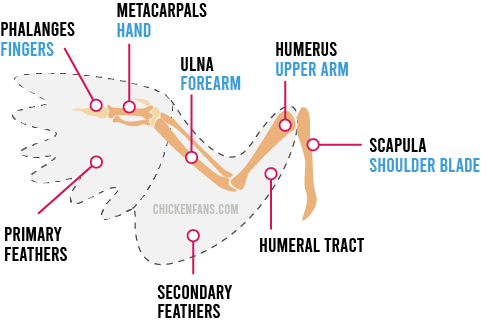
There are some smaller feathers on the humerus (upper arm), but they are not attached to the bone.
Chicken Wing Feather Composition
The wing comprises several main groups of primary and secondary flight and covert feathers.
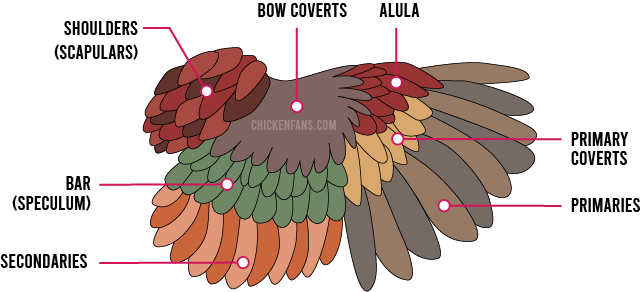
The main feather groups on a chicken wing are:
- Primary Flight Feathers: 10 long, narrow feathers a chicken uses to fly, flap, and lift off. They can spread and rotate. These feathers are cut to prevent a chicken from flying.
- Primary Coverts: the covert feathers that cover the primary flight feathers on the outer wing
- Alula: a group of small flight feathers attached to the chicken’s thumb. Good flyers use this bastard wing to fine-tune their flying angles when landing.
- Secondary Flight Feathers: the flight feathers attached to a chicken’s ulna (forearm). They are kept close together and are shorter and broader than the primaries.
- Wing Bar or Speculum: the row of secondary covert feathers that cover the secondary flight feathers
- Bow Coverts: the upper layer of covert feathers covering the wing bar with secondary covert feathers
- Scapulars: the group of feathers on the upper part of the wing that looks like a shoulder when a chicken is standing still
All these main feather groups have subdivisions.
Chicken Wing Feather Subdivisions
The coverts form rows that overlap each other like roof tiles. The rows are respectively called greater, median, and lesser coverts, with the lesser coverts being the top level.
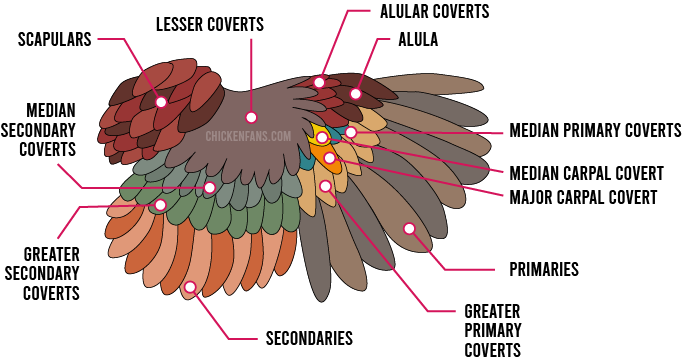
This results in the following feather subgroups:
- Greater secondary coverts: the first row of feathers covering the secondary flight feathers and the first row of the wing bar
- Median secondary coverts: the second row of feathers in the wing bar, covering the greater secondary coverts
- Lesser secondary coverts: the upper feathers, also called the bow coverts
- Greater primary coverts: the first row of feathers covering the primary flight feathers
- Median primary coverts: the second row of feathers covering the greater primary coverts
The alular feathers on the chicken’s thumb also have rows of covert feathers.
What’s unique for chickens and turkeys is that they also have covert feathers attached to their wrist or carpal bones. These are the median carpal covert and the major or greater carpal covert.
Chicken Facial Feathers
Chickens have a feathered head, and some breeds come with extra facial features:
- Ear coverts: small feathers on the back of the eye that cover the ear opening. Chickens have no external ears.
- Crest: a tuft of feathers on the crown of the head in some breeds
- Beard: the fluffy feathers below the beak of a chicken in some breeds
- Muff: the fringe on the cheeks of a chicken that forms in some breeds
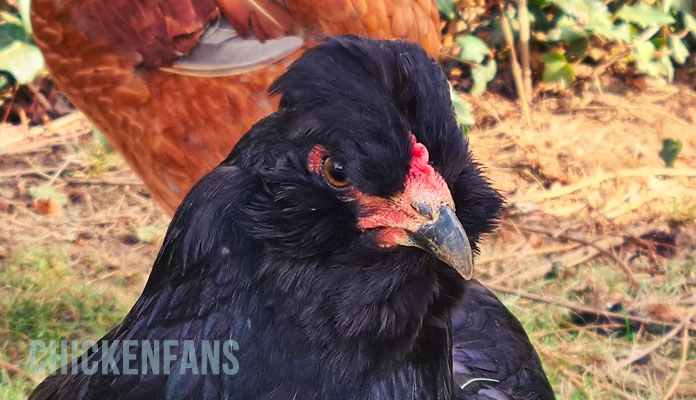
Beards and muffs give a chicken a fancy look and are typical traits in breeds like Araucanas. In 2016 scientists discovered the responsible gene in the chicken’s DNA. The muffs and beards result from a genetic mutation in the HOXB8 gene. The gene sits on a tiny microchromosome with facial skin expressions.
A crest is typical for breeds like the Polish and Brabanter. It’s also gene-controlled and expressed by the Cr-gene.
Chicken Saddle Feathers
Saddle Feathers are the feathers on the back of a chicken, between the neck and tail. Most roosters have glossy, long, pointed saddle feathers. Hens have short, round feathers. The feathers cover the upper and lower saddle. Saddle feathers are popular in fly fishing as artificial flies.
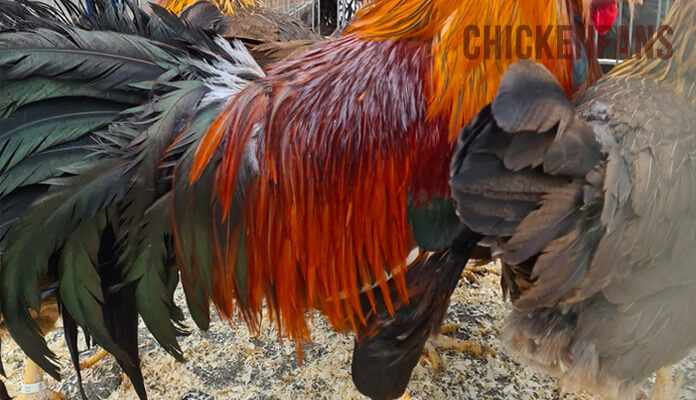
The ground color of a wild-type rooster’s saddle is red to gold, but genes influence the color and saddle striping. Several pattern genes and black pigmentation enhancers alter the look of the upper and lower saddle. For example, partridge-colored roosters show saddle striping, whereas Wheaten coloring has less striping.
Not all roosters have long saddle feathers. Some breeds like Sebrights produce roosters with hen feathering, showing short, rounded saddle feathers. On the other hand, hens never have long saddle feathers.
Roosters with long saddle feathers have been selectively bred for fly fishing. The saddle feathers and hackles resemble dry flies that float on water.
Chicken Tail Feathers
A chicken’s tail consists of central main flight feathers, covered by tail coverts. Roosters also carry sickle feathers on their tails. Sickle feathers are the long, shiny, curved feathers on a rooster’s tail. Hens don’t have sickle feathers.
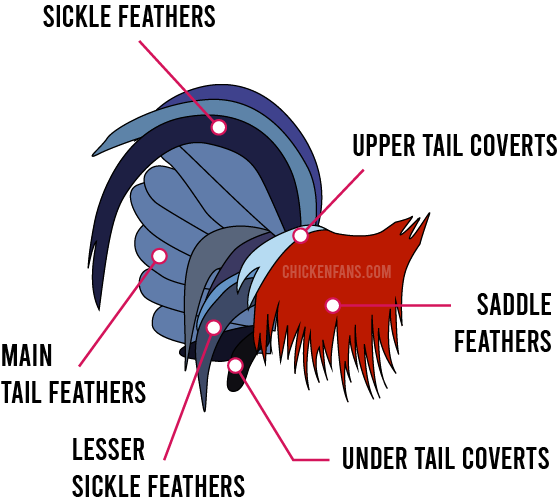
The feathers in a chicken tail:
- Main Tail Feathers: long straight flight feathers that help to brake and steer in flight. These feathers are long and stiff and attach to the pope’s nose of a chicken, which is the protruding last part of the chicken’s backbone
- Greater Sickle Feathers: the long, shiny, curved feathers on the top of a rooster’s tail
- Lesser Sickle Feathers: the smaller, shiny, curved feathers on the lower part of a rooster’s tail
- Upper Tail Coverts: a group of smaller feathers that cover the upper tail and fit nicely next to the chicken saddle. For chickens, they are small, but in peacocks, the elongated upper tail coverts are what people call the ‘tail’ of the peacock.
- Under Tail Coverts: a group of feathers smooth the transition to the body feathers
Chicken Leg and Feet Feathers
Some breeds like Cochins, Brahmas, and Silkies come with feathered feet.
There are two types of feathering on a chicken’s legs:
- Ptilopody Feathers: feathers on the shank, feet, and toes carried by several breeds like Cochins, Brahmas, and Silkies
- Vulture Hock: straight, rigid, rather long, down- and backward-pointing feathers on the lower part of the thighs above the shank of a chicken. They look like flight feathers and are typical traits in breeds like the Belgian D’Uccle and Silkies.
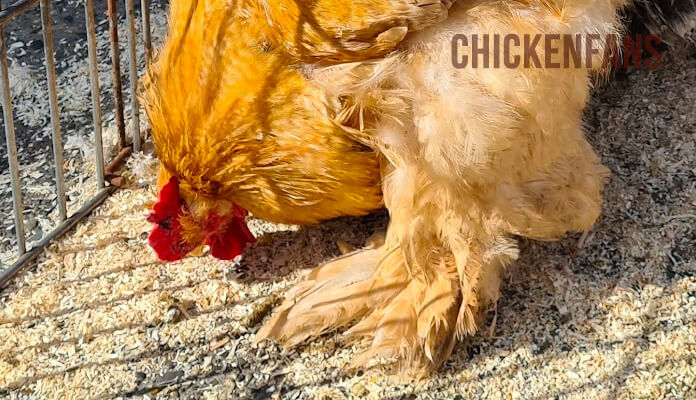
Feathers on the legs make a chicken prone to leg mites and picking. The feathers can also get dirty, wet, and muddy, which can cause trouble in the nesting boxes or cause frostbite during wintertime.
Origins of Leg Feathers in Poultry
Ptilopody feathers (Pti) and Vulture Hocks (V) are gene-controlled. Birds with both the Pti– and V-genes have plenty of feathering on their legs. However, the feathers are not present in junglefowl, the ancestor of the domestic chicken.
Feathers on a chicken’s leg have recently been linked to the DNA of a 125 million-year-old dinosaur, Microraptor Gui. This amazing raptor had four feathered wings to fly around. Their back wings’ anatomy is similar to our domestic chicken’s legs.
Chicken Fluff
The fluff or vent feathers are the small, soft feathers on the bottom of a chicken surrounding the vent. These feathers can get dirty when a chicken sleeps on the ground, in a nesting box, or when there are problems with the digestive tract, such as vent gleet.
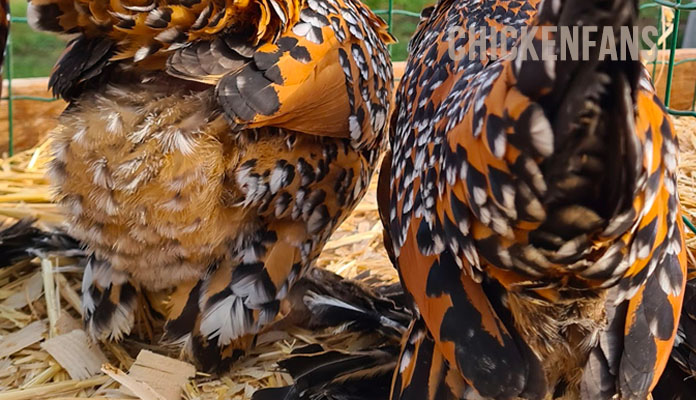
They are popular on social media, where people post photo’s of their chickens on Fluffy Butt Friday.
Hard-Feathered vs. Soft-Feathered
Most chicken breeds have standard hard-feathered plumage with rigid, long, flight feathers.
However, two types of plumage can be considered soft-feathered:
- Silkie Feathering: Silkies have a furry, soft, silk-like feathering. Their feathers lack the tiny hooks that normally attach to barbules on the feather’s shaft; the pattern is called hookless feathering.
- Frizzle: frizzle is plumage with feathers that curl up and curve around the shaft instead of laying in flat layers and rows on the skin, which gives the bird a wooly appearance
Silkie feathering has been crossbreed from Silkies into other breeds such as the Silkie-feathered Chabo variants.
Frizzle Breeding
Frizzle can be seen in any breed but is common in Cochins, Silkies and Polish chickens. There is also the Frizzle breed, a distinct genetic line. Some European countries list the Frizzle as an official breed.
Breeding with Frizzle plumage can be complex because genetic modifiers influence the trait. When breeding Frizzle with Frizzle, the feathers can become extremely curved, narrow, fragile, and brittle. These birds are called frazzles and lose many of their feathers.
Chicken Molt
Molting is a natural process in which chickens change their feathers over a few weeks. They usually molt in the late summer or fall. Some chickens molt so gradually you might not even realize it’s happening, while others run around almost naked. Birds need some extra care during molt.
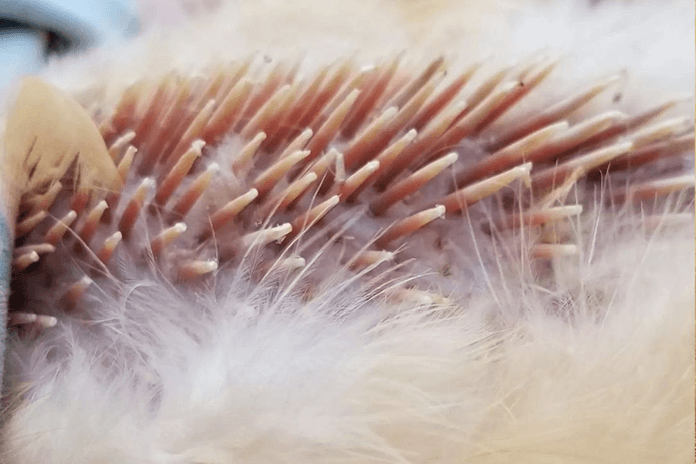
Some poultry goes through an Eclipse Molt. Eclipse Molt is a particular type of molt where the colorful roosters molt into a dull basic plumage after breeding. At that point, they almost look like hens.
Although Eclipse Molt is well known for ducks, it’s also present in junglefowl varieties and game fowl.
Hen Feathering in Roosters
Hen Feathering is a condition where roosters grow the plumage of hens. A genetic mutation changes the bird’s appearance, but the roosters keep their typical behavior. Some breeds like Sebrights and Belgian Campines are naturally Henny-feathered.
Roosters that carry the Hf-gene have higher levels of estrogen, a hormone that triggers female feathering. In the body, estrogen is made from testosterone, the male sex hormone. Chickens with the Hf-gene transform too much testosterone into estrogen, which triggers the female look.
It’s a common belief that roosters with hen feathering have significantly reduced fertility, probably due to high estrogen levels. That’s why some Sebright breeders use roosters that don’t carry the gen.


